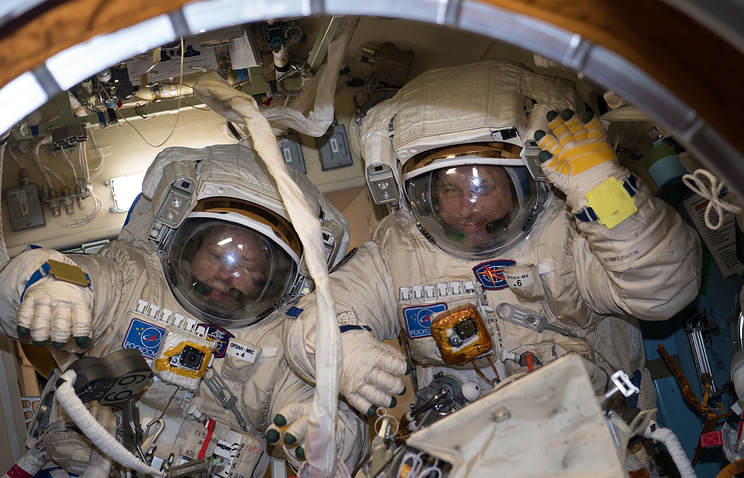Astronauts Misurkin and Shkaplerov have broken the Russian record of being in outer space
The first man in space in 2018 ended successfully. Russian cosmonauts Alexander Misurkin and Anton Shkaplerov replaced the receiver on the antenna of the Zvezda module in order to provide Internet access to the Russian segment of the International Space Station. Prior to this, the relationship depended on the American segment.
The astronauts faced a number of difficulties, spent more than the planned time outside the station and set the Russian record of being in outer space - 8 hours 13 minutes, improving by 6 minutes the output of Oleg Kotov and Sergey Ryazansky, delivered in 2013.

One of the important tasks of the Russian cosmonauts on the International Space Station, scheduled for 2018, was the replacement of the Luch module of the satellite antenna system on the Zvezda module to allow the inhabitants of the Russian station segment to go online, bypassing NASA services.
')
Russian cosmonauts Alexander Misurkin and Anton Shkaplerov on February 2, 2018, at 18:35 Moscow time, left the ISS and went into outer space. Misurkin worked in the new version of the Orlan-MKS spacesuit with a new design of sleeves and trousers made of polyurethane-based material and with an automatic cooling system. The planned operation time was 7 hours. The astronauts had to dismantle the receiving device and install a new broadband module on the antenna. Anton Shkaplerov noted at a briefing in December that the task would be difficult, since it was necessary to unscrew and tighten the many bolts and nuts that you might have to drill.
During the exit, the astronauts faced difficulties - they could not transfer the antenna to the working state from the transport one, as it clung to the structural elements. As a result, the antenna had to be brought not to the normal position, but to a position acceptable for work. Because of this, the astronauts stayed outside the station a record amount of time for Russia - 8 hours 13 minutes. The world record at 8 hours 56 minutes is still held by astronauts James Voss and Susan Helms.
The Internet on the ISS appeared in 2010 to reduce the psychological burden of isolating people from society. As such, there is no Internet access at the station - the data passes through the internal NASA service, and the pages are rendered on Earth, that is, the astronauts see the image through the remote desktop. As a result, the connection is very slow and depends on the state of the Ku-band network, the dish in White Sands, to which the signal goes from the TDRS satellites, the channel to Houston and the channel in Houston.
The old communication module in the Russian segment of the ISS has worked for 17 years. Upgrading the satellite antenna unit will ensure data transmission over the Luch dual-purpose telecommunication satellites , so that astronauts do not have to borrow a communications channel from NASA.
The astronauts faced a number of difficulties, spent more than the planned time outside the station and set the Russian record of being in outer space - 8 hours 13 minutes, improving by 6 minutes the output of Oleg Kotov and Sergey Ryazansky, delivered in 2013.

One of the important tasks of the Russian cosmonauts on the International Space Station, scheduled for 2018, was the replacement of the Luch module of the satellite antenna system on the Zvezda module to allow the inhabitants of the Russian station segment to go online, bypassing NASA services.
')
Russian cosmonauts Alexander Misurkin and Anton Shkaplerov on February 2, 2018, at 18:35 Moscow time, left the ISS and went into outer space. Misurkin worked in the new version of the Orlan-MKS spacesuit with a new design of sleeves and trousers made of polyurethane-based material and with an automatic cooling system. The planned operation time was 7 hours. The astronauts had to dismantle the receiving device and install a new broadband module on the antenna. Anton Shkaplerov noted at a briefing in December that the task would be difficult, since it was necessary to unscrew and tighten the many bolts and nuts that you might have to drill.
During the exit, the astronauts faced difficulties - they could not transfer the antenna to the working state from the transport one, as it clung to the structural elements. As a result, the antenna had to be brought not to the normal position, but to a position acceptable for work. Because of this, the astronauts stayed outside the station a record amount of time for Russia - 8 hours 13 minutes. The world record at 8 hours 56 minutes is still held by astronauts James Voss and Susan Helms.
The Internet on the ISS appeared in 2010 to reduce the psychological burden of isolating people from society. As such, there is no Internet access at the station - the data passes through the internal NASA service, and the pages are rendered on Earth, that is, the astronauts see the image through the remote desktop. As a result, the connection is very slow and depends on the state of the Ku-band network, the dish in White Sands, to which the signal goes from the TDRS satellites, the channel to Houston and the channel in Houston.
The old communication module in the Russian segment of the ISS has worked for 17 years. Upgrading the satellite antenna unit will ensure data transmission over the Luch dual-purpose telecommunication satellites , so that astronauts do not have to borrow a communications channel from NASA.
Source: https://habr.com/ru/post/374221/
All Articles